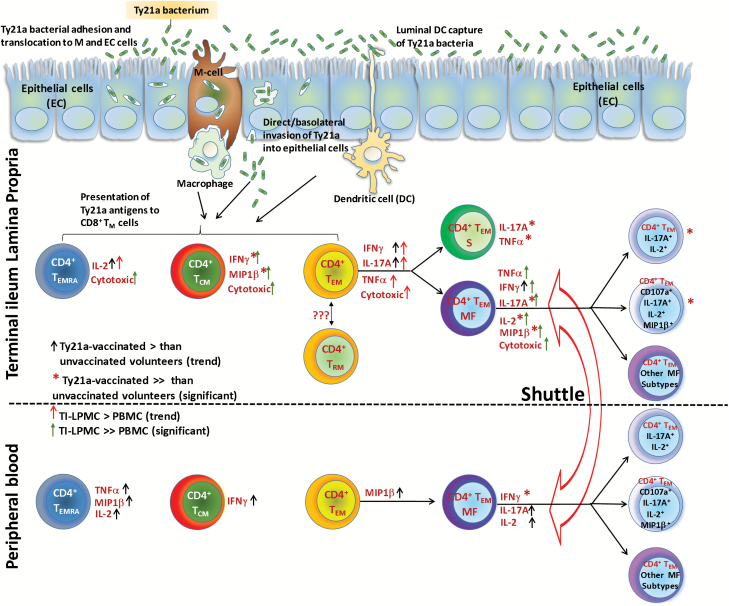Fig. 8.
Cartoon depicting Salmonella Typhi-specific CD4+ TM responses elicited in the TI mucosa and peripheral blood (PBMC) following Ty21a immunization in humans. Following oral immunization with the attenuated vaccine strain Ty21a, these bacteria enter the host by various mechanisms (e.g. M-cell adhesion, epithelial invasion and capture by luminal dendritic cells) and are presented by antigen-presenting cells (APC, i.e. macrophages, dendritic cells) to immune cells (i.e. CD4+ TM) in the lamina propria (LP) compartment. CD4+ TM are subsequently activated to produce higher levels of cytokines/chemokines (IFNγ, TNFα, IL-2, IL-17A and MIP1β) and increased cytotoxicity (up-regulation of CD107a). Following Ty21a immunization each major CD4+ TM (TEM, TCM and TEMRA) subset acquires unique characteristics in the TI-LP. CD4+ TEM responses include single producing effector cells (S) and multifunctional cells (MF). LPMC CD4+ TEM TNFα and IL-17A responses were observed both as S and MF cells while the other responses were observed only as MF cells. The relationship between mucosal and systemic immunity focused on CD4+ TEM responses is also depicted in this cartoon. Following Ty21a immunization, PBMC CD4+ TEM are modulated to produce cytokine responses (IFNγ, IL-17A and IL-2). These responses are almost exclusively as MF cells rather than single producing (S) cells. Of importance, the magnitude of PBMC CD4+ TEM responses is significantly lower than that of LPMC CD4+ TEM as denoted by the green arrows in the LPMC compartment (↑). These results suggest that only CD4+ TEM IL-17A+ S effectors elicited by Ty21a immunization might have the capacity to shuttle between the TI mucosa and peripheral blood or that these cells become MF once they are in the gut mucosa. CD4+ TEM in the TI can be composed of various subsets including tissue-resident memory T cells (TRM) and other CD4+ T-cell subsets. Additionally, CD4+ TEM MF represent 64 different combinations of effector subtypes defined by the expression of CD107a, IFNγ, IL-17A, TNFα, IL-2 and/or MIP1β, including doublet to sextuplet subtypes. This adds another layer of complexity in defining effector responses. This is illustrated in the figure by showing, for example, CD4+ TEM MF quadruplets (subtype CD107a+, IL-17A+, IL-2+ and MIP1β+) which exhibited significantly higher responses in Ty21a-vaccinated than unvaccinated volunteers. Significantly higher responses in Ty21a vaccinees than in unvaccinated volunteers are denoted with red asterisks (*). Trends toward Ty21a vaccinees exhibiting higher responses than unvaccinated volunteers are denoted with black arrows (↑). Significantly higher responses in TI-LPMC compared to PBMC are denoted with green arrows (↑). Trends toward TI-LPMC showing higher responses than PBMC are denoted with red arrows (↑).

